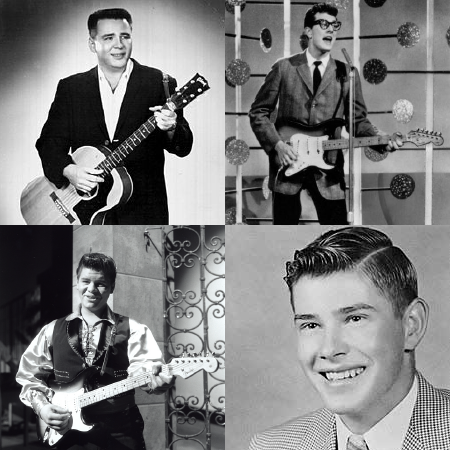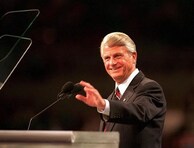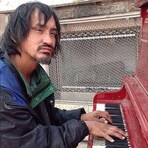The Day the Music Died: Remembering The Lives Lost
Buddy Holly, Ritchie Valens, J.P. Richardson "The Big Bopper" and Roger Peterson

On February 3, 1959, a three-passenger plane went down less than six miles from the airport it had just departed. On that plane, touring musicians Buddy Holly, Ritchie Valens and J.P. Richardson ("The Big Bopper") lost their lives, in addition to the aircraft's pilot, Roger Peterson.
The crash had a monumental impact on the world of music, fans, and popular culture. Following the release of Don McLean's most famous song, "American Pie" the crash was forever billed as 'The Day the Music Died.'
It has been 63 years since the tragic crash that claimed the lives of Buddy Holly, Ritchie Valens, J.P. Richardson and Roger Peterson.
Winter Dance Party
In the early days of 1959, Buddy Holly, Ritchie Valens, The Big Bopper, Frankie Sardo and Dion and the Belmonts embarked on a tour of the midwest United States. The Winter Dance Party was to span Minnesota, Wisconsin and Iowa over the course of 24 days, with Buddy Holly as the lead singer.

The tour did not start on a high note. Poor planning meant the convoy had to travel hundreds of miles each day before evening performances, and frequently backtracked through areas it had already visited. Rough weather conditions and uninsulated tour buses kept the troupe of musicians freezing cold. Drummer Carl Bunch suffered frostbite to his feet while on the tour and was hospitalized; both Ritchie Valens and The Big Bopper started to come down with likely flu.
The Coin Toss
Fed up with the miserable conditions, Buddy Holly decided to charter a plane for his band so that they could warm up and rest before playing the following evening. There were two spots available on the plane, which were intended for Holly's band mates Tommy Allsup and Waylon Jennings. Jennings gave up his seat to The Big Bopper, who was sick with flu-like symptoms.
"According to Jennings' memoir, Waylon: An Autobiography, he and Holly joked about the change in travel arrangements. Buddy told him that 'I hope your damned bus freezes up again.' Waylon replied, 'Well, I hope your ol’ plane crashes.' This casual remark haunted Jennings for years."
What happened next is unclear, but all agree that coin was tossed to determine who would leave the entourage behind and travel by plane to the next destination. According to Allsup's account, Valens approached him and asked for his seat on the plane. The coin was tossed, and Ritchie Valens won by calling heads.
Flight
Pilot Roger Peterson and his high-profile passengers took off at approximately 12:55am on February 3, from Mason City Municipal Airport in snowy conditions. Almost immediately, attempts to make radio contact were unsuccessful. When the plane did not arrive at its destination in Fargo the following morning, a second plane went to look for the missing aircraft.
It was a quick search; the wreckage was found just 6 miles from the airport. There were no survivors.

Remembering the Victims
Buddy Holly
September 7, 1936 — February 3, 1959

From a young age, Buddy Holly played music. Born into a musical family, he learned piano and fiddle as a boy; by the time he finished high school, he'd formed his own band. What started out as country and western quickly took on a more rebellious sound: rock 'n' roll. Inspired by Elvis, the young rocker changed his tune, and soon after signed to a record label.
Under the name The Crickets, the young, bespectacled and clean-cut Holly and his band began pumping out hits. Among Holly's most famous songs ranks "Peggy Sue," "Everyday," "That'll Be the Day," "Rave On, " and "True Love Ways," among others.

In 1958, a great first date with Maria Elena Santiago led to a same-day engagement. The pair married just two months later. Soon after, Maria was expecting a child.
But professionally and creatively, Holly was ready to move on. He left for New York and embarked on a solo career. His split from The Crickets and his producer Norman Petty was messy, and left Buddy hurting for cash. It was only begrudgingly that he agreed to join the Winter Dance Party tour. Ultimately, his dissatisfaction with the touring conditions is what led to the chartered flight.
Buddy Holly's body rests in the City of Lubbock Cemetery, in Texas.

Ritchie Valens
May 13, 1941 — February 3, 1959

Ritchie Valens was just 17 when his life was cut tragically short in the 1959 plane crash. Ritchie Valens was actually a shortened moniker of his name at birth, Richard Steven Valenzuela.
Valens joined his first band in 1958, when he was just 16. While playing shows with The Silhouettes, he was discovered and signed, and began recording songs of his own. "Come On, Let's Go" put the Chicano rocker on the musical radar. Next he released a ballad, "Donna," and what would become his greatest hit, "La Bamba":
"La Bamba" was a revolutionary song that fused elements of a traditional Mexican folk tune with rock and roll. Valens was not a native Spanish speaker and had to be coached on the all-Spanish-language song.
"La Bamba" was released on October 18, 1958 — just a few months before the plane crash. He embarked on the Winter Dance Party with a hopeful career ahead of him, and instead lost his life.

"The Big Bopper" J.P. Richardson
October 24, 1930 — February 3, 1959

At age 29, The Big Bopper was the eldest victim of 'The Day the Music Died'. Born into a blue collar family, The Big Bopper played football in high school, studied pre-law in college, completed two years of military service after being drafted, and went on to work as a radio disc jockey before finding success as a guitar player.
His stage name followed The Big Bopper from his disc jockey days. Beginning as a composer, The Big Bopper wrote tracks for other artists before becoming a recording artist. With the release of "Chantilly Lace" in the summer of 1958, The Big Bopper was on the map. Like Buddy Holly and Ritchie Valens, The Big Bopper's career was still in its early stages. His songs were on the rise by the time he left for the midwestern Winter Dance Party tour.
His pregnant wife Adrienne Joy Wenner and young daughter Debra were left to mourn. Just two months later, his son Jay was born. The Big Bopper's body was buried in the Forest Lawn Memorial Park and Funeral Home Cemetery in Jefferson County, Texas. Fifty years later, rumors that "a gun might have been fired on board the plane and that the Big Bopper might have survived the crash and died trying to get help" led to the exhumation of the grave. Though no evidence of foul play was found, his body was finally able to be viewed for the first time by the son The Big Bopper never met. He was reburied next to his wife's grave.

Roger Peterson
May 24, 1937 — February 3, 1959
Roger Peterson was just 21 when his plane and its passengers went down on, but the young pilot was actually an experienced flyer. After gaining his pilot license in 1955, he immediately began to work as a pilot. At the time of his death, Peterson had four years of experience.
The young pilot was blamed for the crash. Though he had recently completed Flight Instructor certification, he was not qualified to fly at night, or in poor visibility conditions. He was also not properly briefed on the weather conditions prior to takeoff, and had not seen the weather advisory.
Just five months prior to the crash, Roger Peterson married Deanne Lenz. The two had no children. He was survived by his wife, as well as parents Arthur E. Peterson and Pearl I. Kraemer Peterson.
Roger Peterson was buried at the Buena Vista Memorial Park Cemetery in Storm Lake, Iowa.

Reactions and Aftermath
Buddy Holly's unborn child was a secondary victim of the infamous plane crash:
"In Texas, a neighbor told Holly's mother to turn on the radio. When the news report came out, she screamed and collapsed. In Greenwich Village, Buddy Holly's pregnant wife [Maria Elena Santiago] heard the news on television and suffered a miscarriage the following day, reportedly due to "psychological trauma." In the months following the crash, authorities would adopt a policy against releasing victims' names until after the families had been notified."
— Claire Suddath, TIME Magazine
Holly's mother also learned of her son's death via news reports. The changes made to the ways victims' families are notified of deaths is one of the most lasting and important legacies of this tragedy.
The official investigation found that Peterson was not qualified to fly in conditions that obscured his vision from the cockpit; additionally, it was found that he did not have the qualifications to fly the particular aircraft, as he was unfamiliar with the altitude measuring system. It was also found that he was not thoroughly briefed on the weather conditions.
"This accident, like so many before it, was caused by the pilot's decision to undertake a flight in which the likelihood of encountering instrument conditions existed, in the mistaken belief that he could cope with en route instrument weather conditions, without having the necessary familiarization with the instruments in the aircraft and without being properly certified to fly solely by instruments."
— Civil Aeronautics Board Aircraft Incident Report, September 23, 1959
However, not everyone buys the official explanation. Pilot LJ Coon has been public about his doubt, saying the blame of Peterson for the crash is an injustice. He believes that weight imbalances between the passengers aboard the aircraft, or a "possible commotion among the passengers shortly after take-off" may be to blame.
The Winter Dance Party did not stop for death. The tour continued, and was completed on schedule, with Bobby Vee and Waylon Jennings filling in for Buddy Holly.

Cultural Significance
In an instant, the course of music history changed forever. The loss of three rock 'n' roll pioneers in one accident wiped out barrier-breaking talent.
"But February made me shiver
With every paper I'd deliver
Bad news on the doorstep
I couldn't take one more step."
— Don McLean, "American Pie"
In 1971, Don McLean released the American Pie album. The enigmatic title track has mystified fans for years. But it's long been known to reflect the damage of 'The Day the Music Died'. The accident wiped out a burgeoning youthful talent and musical innovation that inspired such artists as The Beatles, the Rolling Stones, Bob Dylan, Billy Joel, Elton John, Eric Clapton, among countless others.
McLean refused to explain the song for years, saying only, "It means I don't ever have to work again if I don't want to." But in 2015, the burning question was finally answered:
"Basically in American Pie things are heading in the wrong direction. ... It [life] is becoming less idyllic. I don't know whether you consider that wrong or right but it is a morality song in a sense."
For many, 'The Day the Music Died' signalled an end of American optimism and innocence. Those who mourned the four young men whose lives were lost also suffered a secondary loss, perhaps even more chilling: the end of an era, and the conclusion of hopes for an American Dream.
To this day, fans gather to honor Buddy Holly, Ritchie Valens and The Big Bopper in an annual concert tribute to the late stars, at the Surf Ballroom. This event is known as The Winter Dance Party.
Despite their early demise, these musicians influenced the music of generations that followed. In addition to Don McLean’s lament on the loss of the American Dream, the popular band Weezer released the song Buddy Holly on what would have been his 58th birthday. The music video won several awards. A number of subsequent top-tier musicians can credit their art in part to the influence of Buddy Holly, and their fame to the path he carved in popular music.





